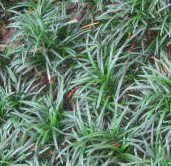 The term grass is generally used to refer to plants with long thin leaves but to be a true grass the plant must be in the family Poaceae (aka Gramineae) This is a large family and includes bamboo, as well as common grains and lawn grasses. Rushes and sedges are closely related to grasses and are generally grouped with them. Several plants, however, look like ornamental grasses but are not related at all. Their common names suggest that they are grasses but once they produce flowers, their true identity is revealed.
The term grass is generally used to refer to plants with long thin leaves but to be a true grass the plant must be in the family Poaceae (aka Gramineae) This is a large family and includes bamboo, as well as common grains and lawn grasses. Rushes and sedges are closely related to grasses and are generally grouped with them. Several plants, however, look like ornamental grasses but are not related at all. Their common names suggest that they are grasses but once they produce flowers, their true identity is revealed.
Grasses, sedges, and rushes all have small inconspicuous flowers but differ significantly in their stem structure and leaf arrangement. The best way to distinguish them is by their stem structure. Most grass stems are round in cross-section and hallow; their leaves are in alternate, in two ranks, and enfold the stem.

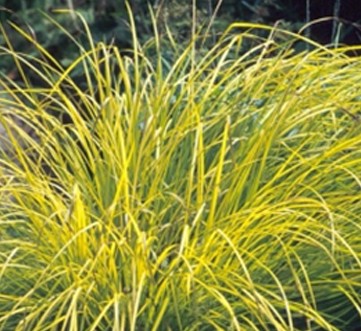 Sedges The stem of a sedge is triangular in cross-section and feels angular if you roll it between your fingers. The leaves are spirally arranged in three ranks. Sedges are very important horticulturally especially the genus Carex which has many species and cultivars that are popular garden plants. This group also includes papyrus and the common lawn weed nutgrass.
Sedges The stem of a sedge is triangular in cross-section and feels angular if you roll it between your fingers. The leaves are spirally arranged in three ranks. Sedges are very important horticulturally especially the genus Carex which has many species and cultivars that are popular garden plants. This group also includes papyrus and the common lawn weed nutgrass.
 Rushes
Rushes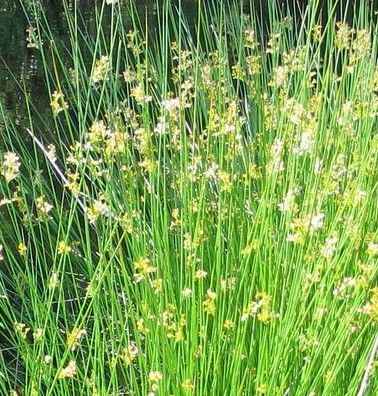 Rushes are more difficult to distinguish but, again, stem and leaf arrangement are the key. Rushes have round stems like grasses but they are solid. The leaves of rushes varies with the species but generally arise from the base of the plant in a spiral. The most important genus of rush is Juncus.
Rushes are more difficult to distinguish but, again, stem and leaf arrangement are the key. Rushes have round stems like grasses but they are solid. The leaves of rushes varies with the species but generally arise from the base of the plant in a spiral. The most important genus of rush is Juncus.
Unlike grasses, sedges, and rushes, the other grass look-alike plants produce flowers with colored petals, although the flowers may be small.
 Turf Lily (Liriope muscari)
Turf Lily (Liriope muscari) Although related to true lilies their flowers are small and produced on spikes in late summer. Plants are tolerant of both sun and shade and can form a dense mat that prevents the growth of weeds. Variegated forms are available.
Although related to true lilies their flowers are small and produced on spikes in late summer. Plants are tolerant of both sun and shade and can form a dense mat that prevents the growth of weeds. Variegated forms are available.
 Mondo Grass (Ophiopogon spp.)
Mondo Grass (Ophiopogon spp.)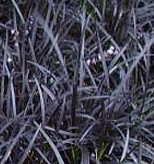 Plants produce low growing tufts of dark green evergreen leaves and spikes of small white or mauve flowers. A black-leafed form is available.
Plants produce low growing tufts of dark green evergreen leaves and spikes of small white or mauve flowers. A black-leafed form is available.
 Sweet Flag (Acorus spp.)
Sweet Flag (Acorus spp.)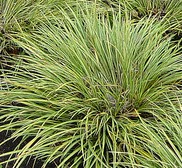 The various common names of Acorus suggest it could be a grass, rush, or sedge but, in fact it is none of these and is related to skunk cabbage and calla lily. The leaves are borne in fans unlike the leaves of true grasses. Both roots and foliage of sweet flag are fragrant. Miniature and variegated forms are available.
The various common names of Acorus suggest it could be a grass, rush, or sedge but, in fact it is none of these and is related to skunk cabbage and calla lily. The leaves are borne in fans unlike the leaves of true grasses. Both roots and foliage of sweet flag are fragrant. Miniature and variegated forms are available.
 Blue-eyed Grass (Sisyrinchium angustifolium)
Blue-eyed Grass (Sisyrinchium angustifolium)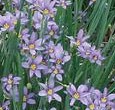 Starry blue flowers half inch across dot the grassy leaves of this plant in early summer giving it its common name. Related to iris, blue-eyed grass form tufts about 12 inches high.
Starry blue flowers half inch across dot the grassy leaves of this plant in early summer giving it its common name. Related to iris, blue-eyed grass form tufts about 12 inches high.
 Iris graminae
Iris graminae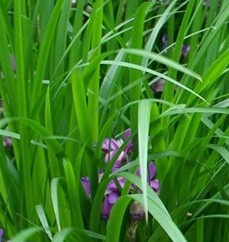 Native from Spain to Russia, the beardless iris produces mounds of dark shining green leave about 6 inches high. In early summer violet and yellow flowers that smell like rotting fruit develop but are almost hidden by the foliage.
Native from Spain to Russia, the beardless iris produces mounds of dark shining green leave about 6 inches high. In early summer violet and yellow flowers that smell like rotting fruit develop but are almost hidden by the foliage.
Some plants are neither sedge or rush like but also lack colorful flowers.
 Cattail (Typha spp.)
Cattail (Typha spp.)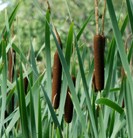 Cattails usually grow in or near water and emerge from thick creeping rhizomes. The flowers and seed heads form a cigar-shaped spike that is pleasing in the garden and the vase. Cattails range in size from tall to miniature and provide a vertical accent to any planting.
Cattails usually grow in or near water and emerge from thick creeping rhizomes. The flowers and seed heads form a cigar-shaped spike that is pleasing in the garden and the vase. Cattails range in size from tall to miniature and provide a vertical accent to any planting.
 Golden Reed (Libertia peregrinans)
Golden Reed (Libertia peregrinans)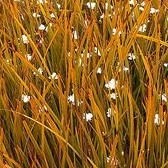 Several Libertias are grass-like but L. peregrinans is the most grass-like. It’s golden orange reed-like leaves are produced in flattened fans and form small tussocks 6 inches tall. The small, white, iris-like flowers appear in summer.
Several Libertias are grass-like but L. peregrinans is the most grass-like. It’s golden orange reed-like leaves are produced in flattened fans and form small tussocks 6 inches tall. The small, white, iris-like flowers appear in summer.